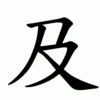及
| ||||||||
 | ||||||||
| ||||||||
Translingual
| Traditional | 及 |
|---|---|
| Simplified | 及 |
| Japanese | 及 |
| Korean | 及 |
| Stroke order | |||
|---|---|---|---|
| Stroke order | |||
|---|---|---|---|
 | |||
Han character
及 (Kangxi radical 29, 又+2 in traditional Chinese and Korean, 又+1 in mainland China and Japanese, 4 strokes in traditional Chinese and Korean, 3 strokes in mainland China and Japanese, cangjie input 弓竹水 (NHE), four-corner 17247, composition ⿻⿹𠄎丿乀(GHJV or U+2F836) or ⿸⿱㇇丿又(TK))
Derived characters
References
- KangXi: page 165, character 3
- Dai Kanwa Jiten: character 3118
- Dae Jaweon: page 374, character 17
- Hanyu Da Zidian (first edition): volume 1, page 35, character 1
- Unihan data for U+53CA
- Unihan data for U+2F836
Chinese
| trad. | 及 | |
|---|---|---|
| simp. # | 及 | |
Glyph origin
| Historical forms of the character 及 | |||
|---|---|---|---|
| Shang | Western Zhou | Shuowen Jiezi (compiled in Han) | Liushutong (compiled in Ming) |
| Oracle bone script | Bronze inscriptions | Small seal script | Transcribed ancient scripts |
 |
 |
 |
 |
Ideogrammic compound (會意) : 人 (“person”) + 又 (“hand”) – a hand grabbing a person.
Etymology
Possibly connected to Burmese ကပ် (kap, “to arrive at”) or Jingpho khap (“to carry, to reach”) (Starostin and Peiros, 1996) or less likely to Tibetan འགྲུབ་པ ('grub pa) ~ འགྲུབ ('grub, “to make ready”), སྒྲུབ་པ (sgrub pa) ~ བསྒྲུབ (bsgrub, “to complete, achieve”), གྲུབ་པ (grub pa, “complete”) (Schuessler, 2007).
Possibly departing tone derivations are 暨 (jì, “to attain, to reach”), 迄 (qì, “to reach to”), and 既 (jì, “already”) (Yu, 1948, Baxter, 1992). However, see those entries for more.
Pronunciation
Definitions
及
- to reach; to extend to
- 觸手可及/触手可及 ― chùshǒukějí ― at one's fingertips; within reach (literally, "can be reached by the touch of hand")
- to catch up to; to reach the level of
- to be in time for; in time
- and; as well as
- 以及 ― yǐjí ― as well as
- 夏,五月,宋人及楚人平。 [Classical Chinese, trad. and simp.]
- From: Commentary of Gongyang, c. 206 BCE– 9 CE
- Xià, Wǔyuè, sòngrén jí chǔrén píng. [Pinyin]
- Summer, the fifth month, the generals of Song and Chu agreed to peace.
- a surname
Synonyms
Compounds
|
|
|
References
- “及”, in 漢語多功能字庫 (Multi-function Chinese Character Database), 香港中文大學 (the Chinese University of Hong Kong), 2014–
Japanese
| Shinjitai | 及 | |
| Kyūjitai [1] |
及󠄁 及+ 󠄁?(Adobe-Japan1) |
 |
| 及󠄃 及+ 󠄃?(Hanyo-Denshi) (Moji_Joho) | ||
| The displayed kanji may be different from the image due to your environment. See here for details. | ||
Readings
References
- “及”, in 漢字ぺディア (Kanjipedia) (in Japanese), 日本漢字能力検定協会, 2015—2023